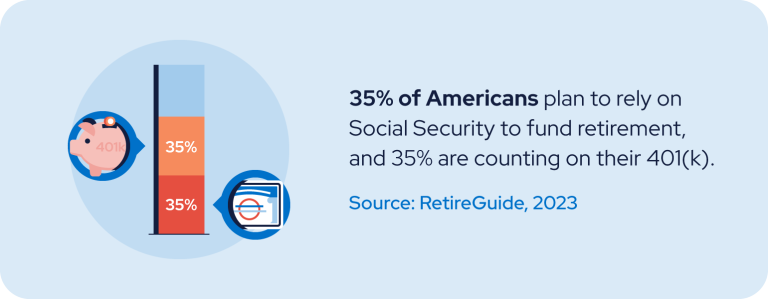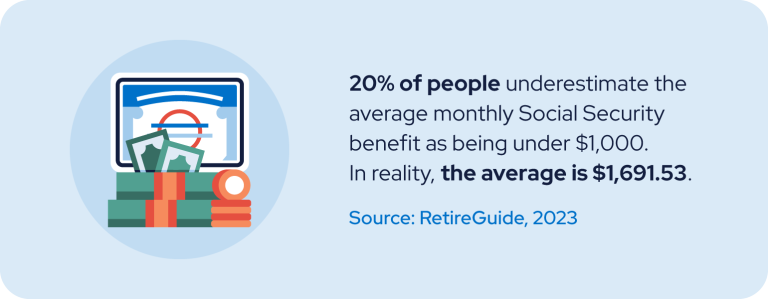12 Steps To Living on Social Security Alone
A new RetireGuide survey reveals 81% of Americans are worried about how inflation may impact their future Social Security benefits. Since 35% of people plan to rely solely on Social Security upon retirement, we mapped out 12 ways to help make it possible to live on Social Security alone.

- Written by Christian Simmons
Christian Simmons
Financial Writer
Christian Simmons is a writer for RetireGuide and a member of the Association for Financial Counseling & Planning Education (AFCPE®). He covers Medicare and important retirement topics. Christian is a former winner of a Florida Society of News Editors journalism contest and has written professionally since 2016.
Read More- Edited By
Lamia Chowdhury
Lamia Chowdhury
Financial Editor
Lamia Chowdhury is a financial content editor for RetireGuide and has over three years of marketing experience in the finance industry. She has written copy for both digital and print pieces ranging from blogs, radio scripts and search ads to billboards, brochures, mailers and more.
Read More- Reviewed By
Brandon Renfro, Ph.D., CFP®, RICP®, EA
Brandon Renfro, Ph.D., CFP®, RICP®, EA
Retirement and Social Security Expert
Brandon Renfro is a Retirement and Social Security Expert and financial planner. He focuses on helping clients create a secure financial future in retirement and co-owns Belonging Wealth Management. He is also a former finance professor and writes for several publications.
Read More- Published: February 24, 2023
- Updated: December 20, 2024
- 8 min read time
- This page features 4 Cited Research Articles
12 Strategies To Help You Retire on Social Security Alone

Enjoying your retirement years while financially relying on Social Security benefits as your primary source of income is achievable. It requires planning ahead and a bit of strategizing to optimize your budget and minimize your expenses. A variety of factors, ranging from insurance to housing to transportation and beyond, require careful scrutiny.
A life supported solely by Social Security may come with challenges and won’t leave room for extravagance. But for those who need to make this situation work, there are some key steps to consider for living on limited retirement income. Here are 12 methods that can help make it easier.

1. Delay Your Social Security
We surveyed over 1,000 Americans and discovered that 35% plan to retire between the ages of 60-65. Although you can file for Social Security once you reach 62 years of age — known as early retirement — full retirement is achieved between 66-67 years old, depending on your birth year. Choosing to retire early can severely impact your Social Security payouts.
To maximize your retirement income, it’s important to wait until you reach full retirement age to claim your Social Security benefits. Doing so will allow you to receive 100% of your benefits, thus maximizing your monthly payout.
If you plan on Social Security covering most or all of your expenses in retirement, it’s important that you manage your expenses and do everything you can to maximize your benefit. Waiting until you turn 70 to file will allow you to withdraw the largest benefit possible.2. Pause Social Security
If you’ve already filed for Social Security but wish you had waited longer in order to increase your benefits, it may not be too late for you to reverse your decision. When you first apply, you have a 12-month window to withdraw your application. The caveat is that you must repay — without interest — any benefits you have received up to that point. This option then allows your Social Security benefits to continue increasing until you choose to file again.
For those who are beyond the 12-month window since applying for benefits, you still have an opportunity to grow your benefit amount. Once you reach full retirement age, you can pause your current benefits indefinitely. You will not be required to repay the money you’ve already received. For each year your benefits remain suspended, up until the age of 70, your retirement benefits will continue to grow.
3. Consider a Move
It’s important to think about the cost of living and the housing costs associated with where you currently live. Calculating the cost of senior housing in your area will show you the realities of financially sustaining these living expenses. Figuring out where your limited income will stretch the furthest can help you identify the best state for retirees.
A move to a more temperate climate may also ease your financial burden, with lower heating and cooling utility costs to manage throughout the year.
4. Pay Off Your Debt Before Retiring
Eliminating high-interest debt, such as credit cards, before you leave the workforce means fewer monthly costs to cover during your retirement. If you can’t pay off credit card debt completely prior to retiring, reducing the balance as much as possible in advance will still help lower your expenses.
Ideally, you will successfully pay off your mortgage before you retire. But if that’s not feasible, do not deplete your personal savings in order to pay it off ahead of your retirement. Just remember to factor those existing mortgage payments into your budget during your retirement planning.
5. Explore Shared Housing Options
Almost 1 in 3 adults over the age of 60 live alone, meaning there are a large number of people retiring single. This creates many opportunities for retirees to split housing costs by taking in a roommate. Sharing household expenses can greatly decrease the monthly living expenses a single person must manage. It also has the added benefit of lessening the risk of isolation that many seniors face, which can be detrimental to their health and well-being.
6. Strategize Social Security Survivor Benefits
Married retirees should closely consider how they set up their survivor benefits in Social Security. Once you or your spouse die, Social Security payouts will remain for one dollar amount. The survivor will receive ongoing payments for the higher amount between the two spouses’ original benefit payments. Because of this, many couples opt to have the higher earner postpone accessing their Social Security benefits as long as possible. This enables the surviving spouse to receive the maximized benefits for the remainder of their lifetime.
7. Get Help To Plan Ahead
Consider working with a retirement planner to help you calculate your optimal retirement finances. They can help you gain a clear picture of your current finances before retirement and strategize ways to make your Social Security benefits stretch to fund your life after retirement.
8. Decrease Your Transportation Costs
Removing car payments and the associated costs of owning and operating a vehicle can greatly decrease your monthly expenses. There are a variety of ways for seniors to get around town, such as rideshare services, public transportation and senior transport services. For those physically able, walking and bike riding offer added health benefits.
9. Research Community Assistance
Your local community is most likely home to a multitude of organizations that offer services to support low-income seniors. Food programs such as Meals on Wheels can help you cut food costs. Many communities also have programs featuring free or low-cost engagement activities optimized for seniors.
10. Stay Active and Healthy
It’s vital that seniors remain physically and mentally active in order to maintain good health and increase their longevity. By doing so, they can keep health care costs low and avoid the need for in-home health care services, which can be quite expensive.
11. Monitor Your Expenses
Gaining a clear understanding of your monthly expenses is important to strategize how to best thrive while living solely on Social Security. Mapping out where every dollar goes will allow you to identify places where you can more easily cut costs. And staying vigilant in tracking your expenses while living on a fixed income will help you be better prepared when unexpected costs arise.
12. Maximize Free and Discount Options
There are many opportunities to find senior discounts and freebies both online and in local communities. You may find savings on dining, retail shopping, travel and even prescription drugs. Some museums, libraries and parks also offer free or discounted access for the community, creating additional opportunities to keep your mind and body active. Every penny saved can help stretch out your monthly Social Security income.
35% of People Plan To Live on Social Security Alone in Retirement

When asked what they anticipate using as their primary financial source for their retirement, survey respondents favored one of two options. Thirty-five percent indicated that they would rely on Social Security payments, while another 35% noted that their 401(k) would serve as their primary retirement funding source. Only 3% of Americans plan to rely on annuities, which offer another option for a guaranteed income stream.
The survey also revealed 52% of older adults age 60 and over are more likely to see Social Security as their primary retirement funding. Comparatively, 42% of adults ages 45-60 feel the same way, but only 24% of those 30-44 and 21% of people 18-29 agree.
Gen X adults were far more likely to lean toward the 401(k) as their main retirement financial support. Forty-one percent of respondents ages 30-44 plan to use their 401(k), compared to only 20% of adults over 60 who plan to do the same.
81% Are Worried About Inflation’s Impact

Four out of five people surveyed are concerned about the effect current inflation may have on their Social Security benefits. Survey responses indicated that 42% are very worried, 27% are somewhat worried and 11% are slightly worried. Female respondents are the most anxious about inflation’s impact, with 46% of women feeling very worried. In comparison, 39% of men held the same fears.
Some people are unaware that Social Security incorporates cost of living adjustments (COLA) as a method of keeping payments in line with current inflation. But these COLA increases have not kept up with rising inflation rates. In late 2022, the Social Security Administration announced an 8.7% COLA to take effect in January 2023 in an effort to counteract the 9.1% inflation peak reached in 2022.
Most Are Confused About Social Security Payouts

According to the Social Security Administration, the average monthly Social Security benefit is $1,691.53. When surveyed, 20% of Americans seriously underestimated the average monthly payout as being under $1,000, and 15% of people simply had no idea what that monthly total could be.
The confusion experienced by these Americans is understandable considering how the SSA calculates Social Security benefits. The formula they use is based in part on a person’s lifetime earnings and multiple indexes that account for changes in average wages over the years since earnings were received. Thankfully, the average retiree does not need to worry about that complicated math and only needs to focus on the Social Security benefits that apply to them.
In order to make living on Social Security alone a reality, it’s important to examine your entire financial situation so you can make adjustments to maintain a good quality of life on a tight budget. Learning how to maximize your Social Security benefits is the key to thriving during your retirement.
Methodology
The survey of 1,036 U.S. adults 18+ was conducted via SurveyMonkey for RetireGuide on February 3, 2023. Data is unweighted and the margin of error is approximately +/-5% for the overall sample.Last Modified: December 20, 2024Share This Page4 Cited Research Articles
- Social Security Administration. (2023, February). Research, Statistics & Policy Analysis: Monthly Statistical Snapshot, January 2023. Retrieved from https://www.ssa.gov/policy/docs/quickfacts/stat_snapshot/
- Social Security Administration. (2022, October 13). Social Security Announces 8.7 Percent Benefit Increase for 2023. Retrieved from https://www.ssa.gov/news/press/releases/2022/#10-2022-2
- Social Security Administration. (2022, January). Your Retirement Benefit: How It’s Figured. Retrieved from https://www.ssa.gov/pubs/EN-05-10070.pdf
- Social Security Administration. (n.d.) Suspending Your Retirement Benefit Payments. Retrieved from https://www.ssa.gov/benefits/retirement/planner/suspend.html
- Edited By
Your web browser is no longer supported by Microsoft. Update your browser for more security, speed and compatibility.
If you need help pricing and building your medicare plan, call us at 844-572-0696


